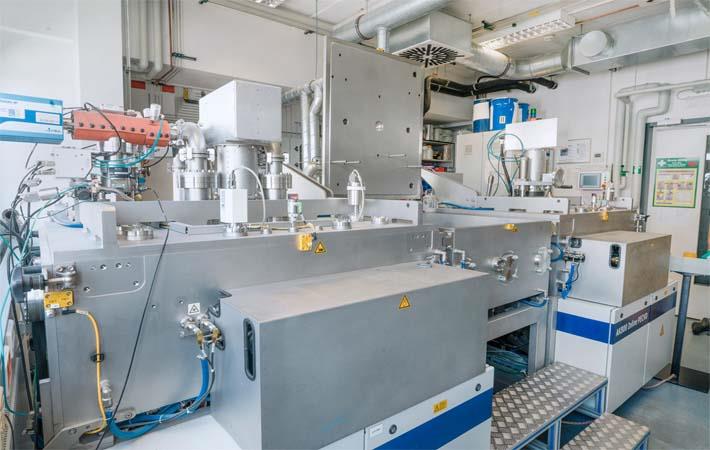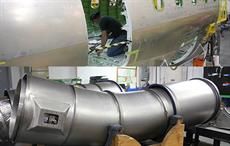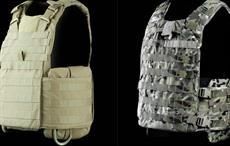Fraunhofer researchers with industrial partners have developed textile-based solar cells which could add a new dimension to photovoltaics, complementing the conventional silicon-based solar cells. Currently, solar panels on building roofs are used for energy generation. New solar cells could open way for use of other surfaces for photovoltaic generation.
Fabric-based solar cells are expected to be ready for market launch in around five years.Fraunhofer researchers with industrial partners have developed textile-based solar cells which could add a new dimension to photovoltaics, complementing the conventional silicon-based solar cells. Currently, solar panels on building roofs are used for energy generation. New solar cells could open way for use of other surfaces for photovoltaic generation.#
Imagine a truck tarp that can harvest the energy of sunlight! With the help of new textile-based solar cells developed by Fraunhofer researchers, semitrailers could soon be producing the electricity needed to power cooling systems or other onboard equipment. In short, textile-based solar cells could soon be adding a whole new dimension to photovoltaics, complementing the use of conventional silicon-based solar cells.
Solar panels on building roofs are a common enough sight today – as are large-scale solar parks. In the future, other surfaces may also be exploited for photovoltaic generation. Truck tarps, for example, could be used to produce the electricity consumed by the driver when underway or parked up for the night, or to power electronic systems used to locate trailers in shipping terminals. Similarly, conventional building facades could be covered with photovoltaic textiles in place of concrete render. Or the blinds used to provide shade in buildings with glass facades could be used to create hundreds of square meters of additional surface for producing power.
Pliable, textile-based solar cells have been developed at the Fraunhofer Institute for Ceramic Technologies and Systems IKTS in collaboration with the Fraunhofer Institute for Electronic Nano Systems ENAS, Sächsisches Textilforschungsinstitut and industrial partners Erfal, Pongs Technical Textiles, Paul Rauschert and Gilles Planen.
“There are a number of processes that enable solar cells to be incorporated in coatings applied to textiles,” explains Dr. Lars Rebenklau, group manager for system integration and electronic packaging at Fraunhofer IKTS. In other words, the substrate for the solar cells is a woven fabric rather than the glass or silicon conventionally used.
“That might sound easy, but the machines in the textile industry are designed to handle huge rolls of fabric – five or six meters wide and up to 1000 meters in length,” explains Dr. Jonas Sundqvist, group manager for thin-film technology at Fraunhofer IKTS. “And during the coating process, the textiles have to withstand temperatures of around 200 °Celsius. Other factors play a key role too: the fabric must meet fire regulations, have a high tensile strength and be cheap to produce.”
“The consortium therefore opted for a glass-fibre fabric, which fulfils all of these specifications,” Rebenklau says.
Researchers also faced the challenge of how to apply the wafer-thin layers that make up a solar cell – the bottom electrode, the photovoltaic layer and the top electrode – to the fabric. These layers are between one and ten microns in thickness. By comparison, the surface of the fabric is like a mountain range. The solution was first to apply a layer that levels out the peaks and troughs on the surface of the fabric. For this, researchers opted for a standard process from the textile industry: transfer printing, which is also used to rubberise fabrics. All the other processes have been adapted in such a way that they can be easily incorporated in standard production methods used in the textile industry. For example, the two electrodes – which are made of electrically conductive polyester – and the photovoltaic layer are applied by means of the common roll-to-roll method. The solar cells are also laminated with an additional protective layer in order to make them more robust.
The team has already produced an initial prototype. “This has demonstrated the basic functionality of our textile-based solar cells,” Rebenklau says. “Right now, they have an efficiency of between 0.1 and 0.3 per cent.” In a follow-up project, he and the team are seeking to push this over the five per cent mark. This will make the textile-based solar cells commercially viable.
Silicon-based solar cells are significantly more efficient, at between ten and 20 per cent. However, this new form of solar cell is not intended to replace the conventional type, but is merely meant to offer an alternative for specific applications. In the coming months, the team will be investigating ways of enhancing the service life of the fabric-based solar cells. (SV)
Fibre2Fashion News Desk – India


